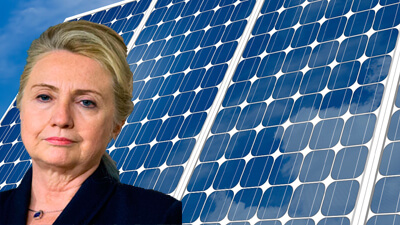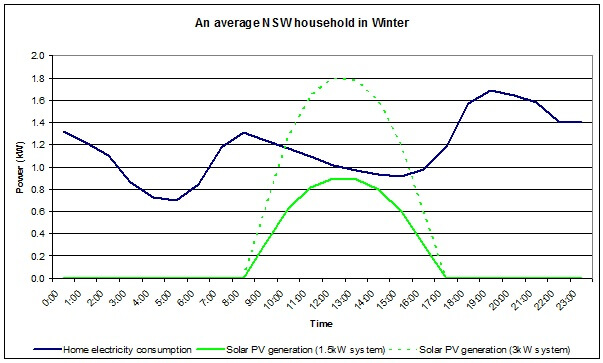Ricochet is the best place on the internet to discuss the issues of the day, either through commenting on posts or writing your own for our active and dynamic community in a fully moderated environment. In addition, the Ricochet Audio Network offers over 50 original podcasts with new episodes released every day.
 Clinton’s Solar Panel Plan Leaves America in the Dark
Clinton’s Solar Panel Plan Leaves America in the Dark

On Hillary Clinton’s campaign website, she calls for the creation of 500 million new solar panels to “power every home in America.” Voicing a strong preference for solar may win over the hearts of some environmentally conscious voters, but it should not win over their minds. A proposal to comprehensively retool the nation’s energy systems to solar power ignores a couple of very basic, yet critically important, complications.
First, every home in America is already powered. The country does not need to undergo a massive, redundant, and expensive overhaul to duplicate what has already been accomplished. Second and more importantly, this plan, if you can call it that, hinges on a physical impossibility. Solar panels cannot power homes. At least not in any way people in the industrialized world would consider acceptable. Solar power is unreliable, intermittent, and inflexible. This means solar panels are intrinsically incapable of handling the country’s home energy needs.
Energy is consumed on demand, without advance warning or notice. When anyone flicks on a light switch in their home, the unthinking expectation is that their lights will automatically turn on. That taken-for-granted miracle of convenience and standard of living is made possible through a steady and uninterrupted access to electrical energy. To ensure people always have electricity when they want to use it, power plants must use fuel sources that can continually power electrical generators. In practice, these fuel sources are limited to coal, natural gas, oil, nuclear, and hydro, and according to the Energy Information Agency those sources combine to generate 92 percent of America’s electricity in 2015.
On the other hand, renewable energy sources, like wind and solar, cannot produce power on demand. Windmills and solar panels produce energy literally as the wind blows and sun shines. Because of this intermittency, renewable energy, as it is widely known, is unreliable energy. Alex Epstein, author of The Moral Case for Fossil Fuels, coined the term “unreliables” to replace “renewables,” as it is a much more accurate description of what they offer to energy consumers. This is not to say that solar panels serve no purpose, but we all use electricity throughout each and every day, not just when the sun is being cooperative. Imagine depending solely on solar panels for your home electricity – your access to this critical resource could be cut off by something as simple and commonplace as cloudy skies. In your homes, you cannot afford to have all your lights and appliances shut off just because it’s overcast outside.
If you think this is an oversimplified review of solar energy, it actually gets worse as you consider more details.
Daily kilowatt consumption follows a predictable pattern of highs and lows over a full day, but the amount consumed at any given moment in any given region is in constant flux. Solar, unlike traditional fuel sources for electrical energy, cannot be adjusted to meet the moment-by-moment changes in energy consumption. Even when the sun does come out and solar panels start creating electricity, there is no assurance that whatever energy produced will match whatever energy is being consumed. Solar energy cannot be ramped up or dialed down to match demand. We are stuck with whatever the weather gives us.
Worse than this inflexibility, the very nature of the rotation of the Earth guarantees that solar panels will not generate electricity when it is needed most. People need energy 24 hours a day, but in their homes specifically, they need it most when the sun isn’t shining. Home electricity consumption peaks in the early morning before people leave for work and school and again in the evening when they return home. The bulk of home energy consumption happens when the sun is not shining and peak solar production occurs when it is needed least. The graph below, created by an Australian solar energy broker, illustrates this inversion between home energy demand and solar production.

Source: http://www.solarchoice.net.au/blog/home-energy-consumption-versus-solar-pv-generation/
If you consider your own daily routines, you will likely see why this is. The average working American wakes up and starts using electricity before the sun is up. In the dark or dimly lit morning hours, people turn on lights, pull food out of the refrigerator (which has been using energy throughout the darkness of the night), use their stoves or microwaves to make breakfast, and groom themselves with any number of bathroom appliances. During the daylight hours, when solar has the greatest potential to generate power, home electricity consumption drops off because most people have gone to work or school for the day. When they return home, as the sun is setting and solar production falls off, they turn on all the lights again, use their stoves or ovens to make dinner, turn on their TVs, and use their computers to read the latest on Ricochet.
Building 500 million new solar panels could, in theory, expand solar capacity enough to handle all the daytime home electrical demand, but the true capacity for unreliable energy sources is always zero. Clinton could subsidize the solar panel portfolio to be 100 times more than what is needed, but on a sufficiently overcast day, let alone at night, they would all be for naught. A solar panel sitting in the dark cannot turn your lights on. No matter how heavily the government invests in solar, reliable and controllable sources (fossil fuels, nuclear, hydro) will always be needed to maintain steady and affordable access to energy.
Published in Science & Technology, Technology



Ross,
You bet it is. This is the solar scam that has been spun on the American Taxpayer for 40 years. I’ve been talking about the real thing. No subsidies. If it can fly under its own power it flies. The utility just needs to play by a set of equitable rules and consumer-generated power could happen.
Of course, it would require politicians that weren’t knuckleheads. On second thought just forget it.
Regards,
Jim
Larry: I really wasn’t addressing your situation at all. It sounds like your state has screwed you over.
You are comparing apples and oranges. Power from a large solar plant is very different than power fed into the grid piecemeal from thousands of private installations widely distributed across the area the grid serves. A large solar plant may have its own buffers to manage fluctuations in output, its panels (or thermal collectors) are of known quality, it’s professionally managed and controlled, etc.
You also put words in my mouth: At no point did I say that solar power was useless. What I said is that it’s very expensive in most cases, and that forcing a utility to take feed-in from thousands of small power sources is not a cost-free operation for the utility.
Or ask yourself this: If the utility had the option to buy stable power from a gas turbine at $.10 per kWh, or buy intermittent energy from thousands of small providers at $.10 per kWh, which one do you think they’d pick? I think the answer is obvious. So the next question is, how much cheaper do you think the solar power would have to be before the utility would voluntarily choose to buy it over an equivalent amount of traditional power?
Whatever that number is, (and it’s not zero) represents the loss the power company is taking if it is forced to buy feed-in solar at the same price at which it buys traditional power.
Jim, do I understand you to believe that solar power would be cost competitive with traditional forms of power generation if the politicians just got out of the way? If so, I beg to differ. Solar power simply cannot be generated in large amounts for anywhere near the price of coal, natural gas, nuclear, or hydro power. Not today, anyway. Every country that has tried to implement large-scale solar has seen its power costs go up, and often very dramatically.
Now, there are a few select places where solar power may be close to matching grid power. Those would be places where grid power is already expensive due to local conditions, where there is plenty of sunlight, and where there is plenty of inexpensive land very near the consumers of the electricity. The problem with solar is that the costs go up dramatically when any of those conditions do not hold, and that means there are very few places where solar might conceivably be cost efficient.
The same is true for wind power. Much has been made of the few wind power plants that operate near breakeven, but the locations suitable for wind power of the highest efficiency are few and far between. So wind power simply doesn’t scale. Once you get away from the areas of high, relatively constant winds located near major metro areas, the cost of wind power starts to go up exponentially. But greens always point to these low-hanging-fruit installations and use them to claim that we can build similar plants across the country. It just doesn’t work that way.
With solar power, if you don’t have a south facing roof, if you live in a northerly area where the solar flux is lower, or an area that is more naturally cloudy than the deserts of Nevada, or an area where it snows and the snow can be expected to cover the panels from time to time, the economics change dramatically.
Dan,
You are making my point in a way. If the subsidy nonsense would stop and 1/1000 of the effort to drive everyone nuts about MMGW and renewables would be put into simple monitoring controllers that the utility would spec and the homeowner would pay for, then the utility could set an equitable price. None of what I suggest is all that difficult to do. We would then see that the enterprising homeowner and the enterprising independent panel maker can fill the bill. No one would do solar unless all the conditions were right and money flowed into their pocket. All local conditions would be taken into account with nobody being forced to do anything. You know just like every other product in the free market. It would cost the taxpayers nothing and I could stop hearing about saving the planet with green energy. I am not suggesting any solar large scale production at all.
Unfortunately, we are all too used to top-down monopoly control extorting the last nickel. Lincoln gave the farmers 160 acres and a mule to get them started. If the Railroads had monopoly control of everything there still wouldn’t be any corn grown in Iowa. If the Railroads had been asked what they thought of the Interstate System we wouldn’t have I-1 much less I-95.
Regards,
Jim